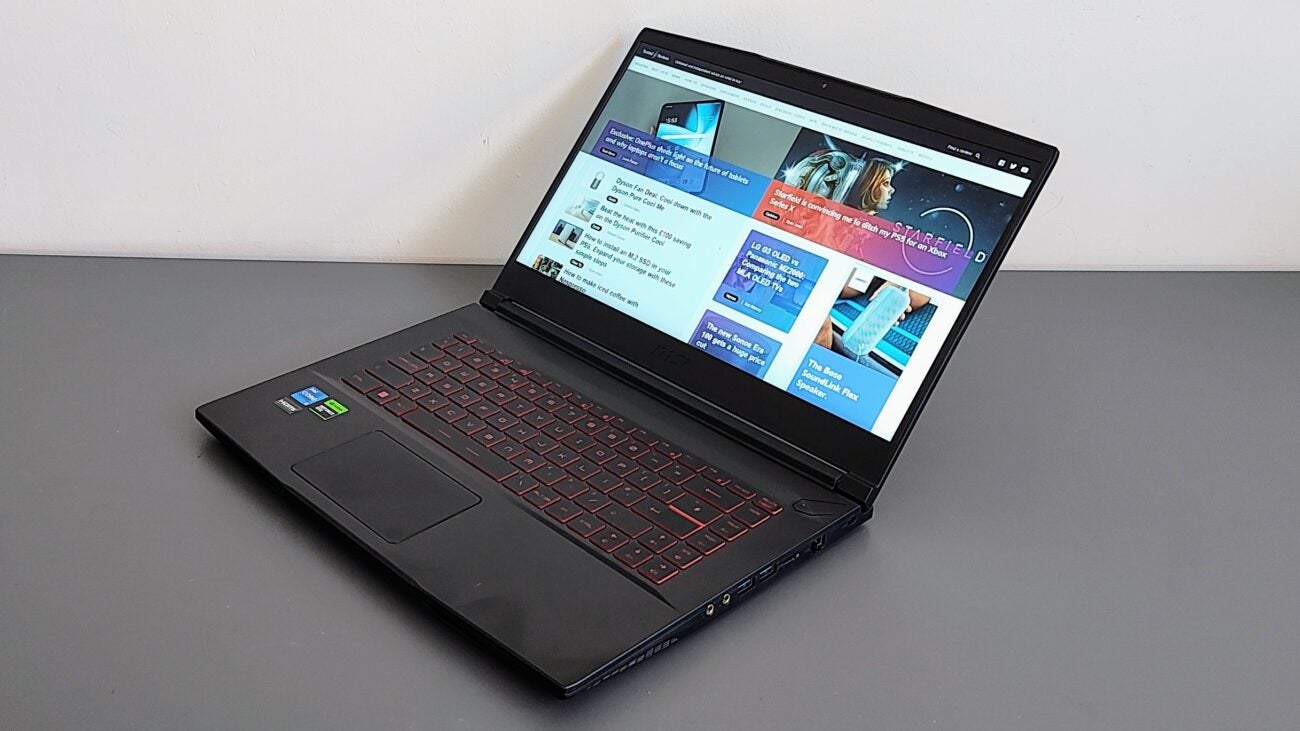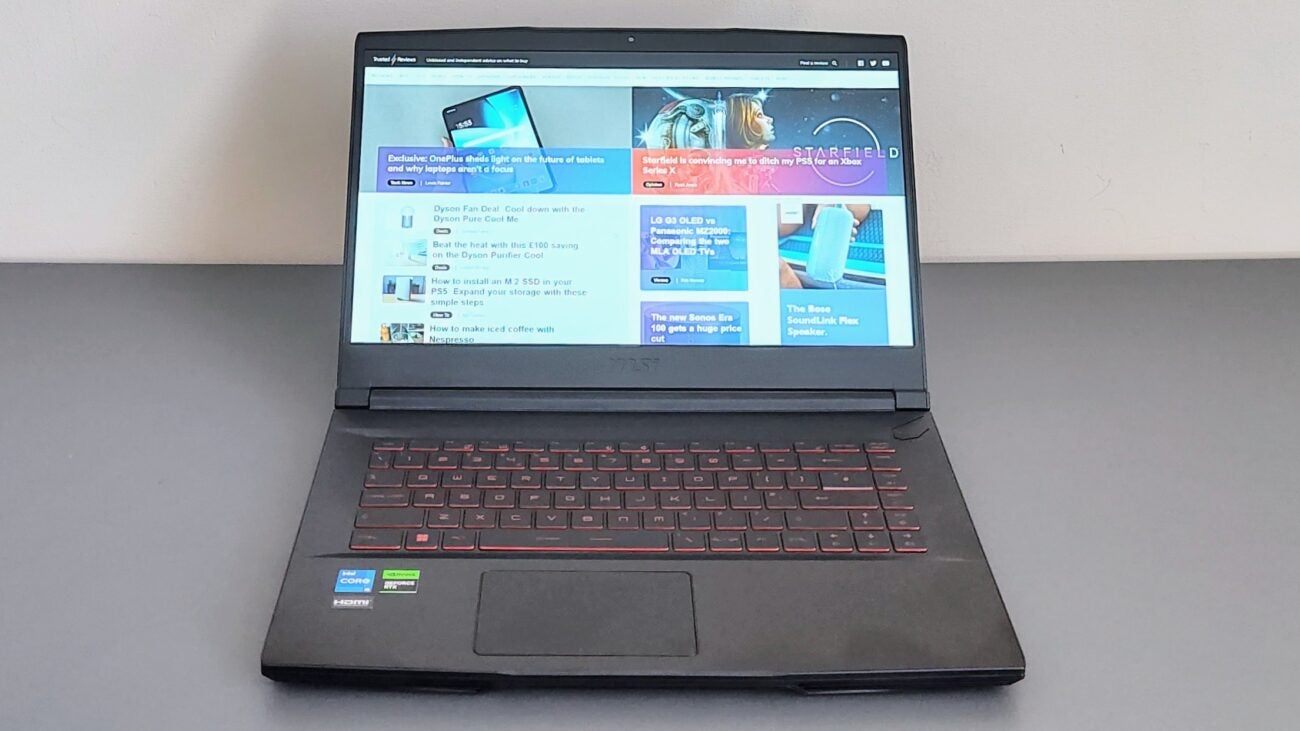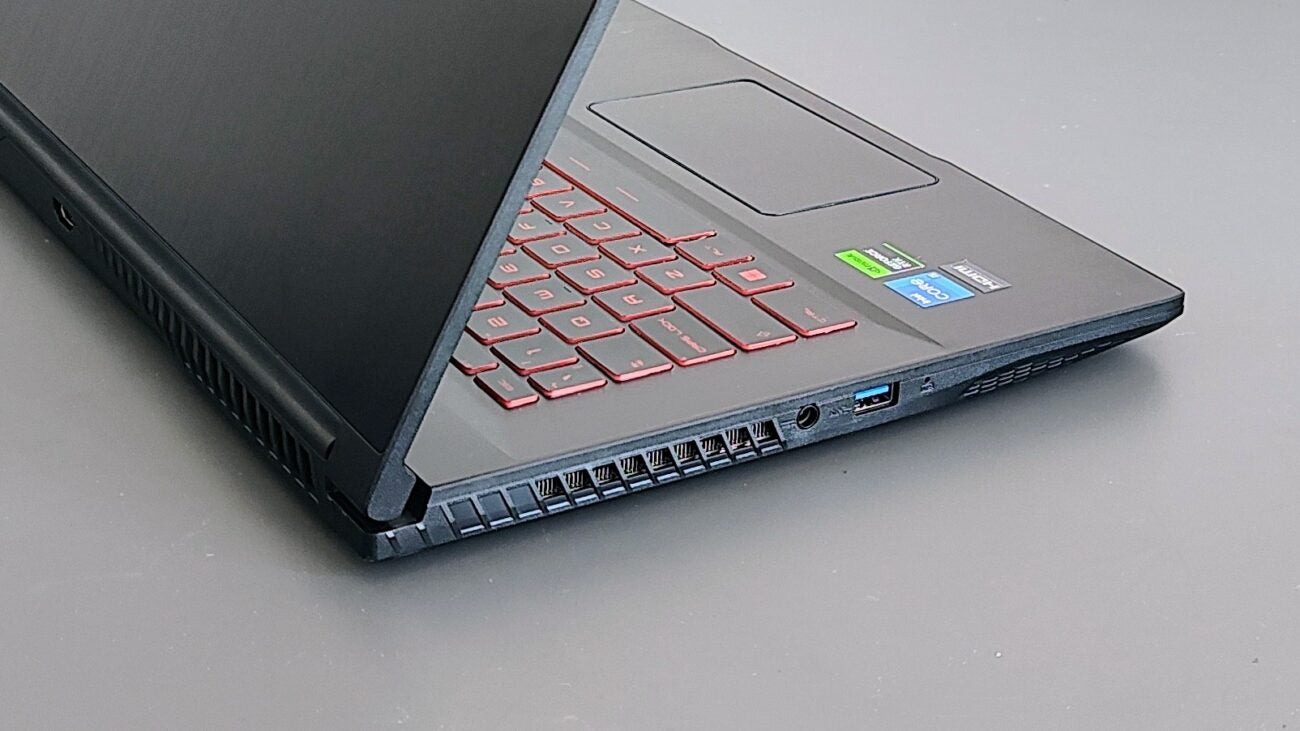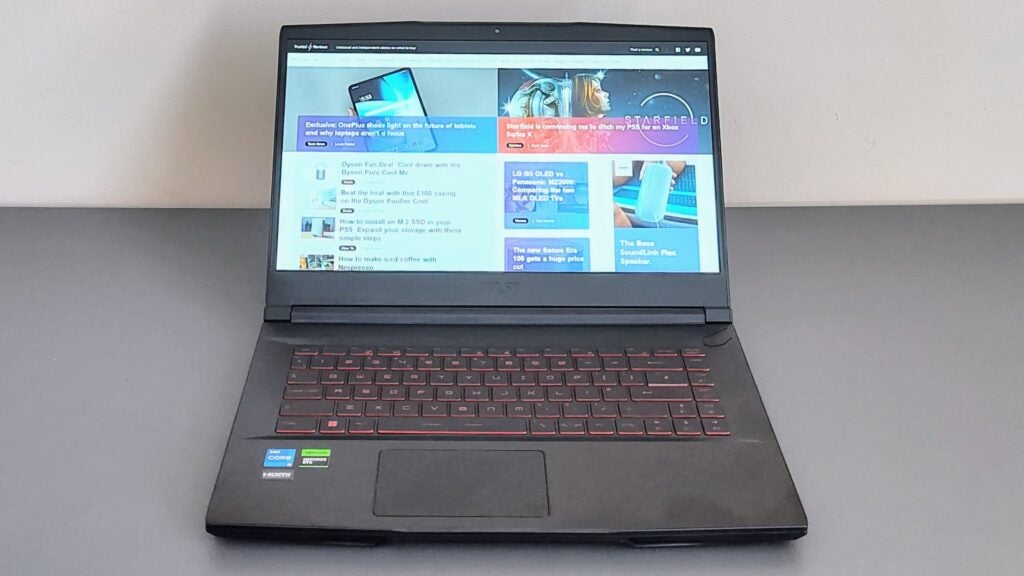MSI GF63 Thin (2023) Review
RTX 40-series gaming on the cheap








Verdict
The MSI GF63 Thin has cut some corners to deliver an RTX 40-series laptop for under £900, but it adds up to a great value pick.
Pros
- Impressive value
- Stylish and compact
- Good port selection
Cons
- Last-geneneration 12th Gen Core i5
- RTX 4050 only has a max TGP of 45W
- The keyboard action is shallow
Key Features
- The cheapest RTX 40-series GPU laptop in the UKTakes advantage of Nvidia’s DLSS 3 upscaling technology
- 15.6-inch gaming laptopThe part-aluminium and part-plastic weighs only 1.86kg
- Good range of ports3 x USB-A 3.2 Gen 1 and USB-C and more
Introduction
MSI’s entry-level Thin and Katana-series gaming laptops have always offered decent gaming capability at a very reasonable price. Typically, they employ the latest generation GPUs but partnered with slightly older Intel CPUs. The 2022 Thin GF63 11UC was a classic illustration of this. Now, the latest MSI GF63 Thin has arrived.
The latest MSI Thin GF63 machines have now rocked up featuring the latest RTX 40-series GPUs from Nvidia but 12th rather than 13th generation Intel chips. This gives a little away in terms of processor performance to the latest Raptor Lake CPUs but since the Alder Lake chips that preceded them were no slouches the impact is bordering on the minimal.
The effect that this strategy has on price is not to be underestimated because if you shop around cannily (MSI regularly runs promotions with its key retail partners) the new Thin GF63 can be picked up for under £900 which is dirt cheap for a laptop with the latest generation graphics card though it’s a fair bit more than 2022 model which can be picked up for £700.
Design and Keyboard
- The all-black aluminium case is very stylish
- Compact and light for a 15.6-inch gaming laptop
- The keyboard is shallow and vague
The 2023 GF63 looks and feels a lot like the old RTX 30/Tiger Lake-series model from 2022. That means that get an aluminium lid and keyboard deck and a rather more substantial feel than you might expect for this price. The all-black surface really shows up fingerprints though and very quickly starts to look like a smudgy mess as you can see in these photographs.
At 21.7mm thick, I’m not sure I’d actually describe the Thin as thin, but it only weighs 1.86kg and it’s a petite 359 wide x 254mm deep. For a 15.6-inch laptop, it’s certainly very portable. The 120W power brick is usefully small and light too.
When it comes to I/O ports MSI has done a good job with the GF63. On the right slide, you’ll find two USB-A 3.2 Gen 1 data ports, a Type-C port of the same spec that also supports DP Alt Mode video output, a 1 gigabit RJ-45 LAN port and two 3.5mm audio jacks, one mic-in, one headphone-out.

On the opposite side, is another USB-A and the DC-in jack while at the back is a solitary HDMI 1.4 video output. That’s a decent selection of I/O ports though given the choice I’d have preferred the power jack to be at the back next to the HDMI and Type-C on the left to make things more balanced ergonomically.
The display is sandwiched top and bottom between rather thick plastic bezels – 17mm above and 27mm below – which lends the GF63 a slightly old-fashioned look with the lid up. Above the screen sits a 720p webcam that captures a reasonably crisp and colourful image though it doesn’t support Windows Hello facial recognition which is a shame in the absence of a fingerprint scanner on the keyboard. The F6 key serves to turn the webcam on and off if you are worried about prying eyes.
The base of the keyboard is more flexible than I would like and the action is both shallow and vague with a febrile and cheap feel to it. It’s not a keyboard I’d like to spend any length of time typing or gaming on. The red backlight has three levels of brightness and as both the keycaps and sides are painted red it looks much the same even when the backlight is turned off.

There’s very little in the way of gaming optimization so there is nothing to distinguish the WASD keys. There are however four full-sized arrow keys and an extra row of keys at the far right for Page Up, Down, End and Home. The volume and display brightness FN controls are also all on the lower right of the keypad rather than on the F row at the top which these 6 keys without a job.
At 105 x 65mm, the plastic trackpad is a little on the small side but it works reliably and the click-action has a clean and precise action.
Getting the bottom panel off the GF63 is not at all easy because the 3.5mm and USB connectors on the right all want to come off with the base and I could find no way around that. You also need to remove the plastic bar between the hinges and peel away a factory seal sticker.

Assuming you manage to open it up, or you take it to a professional, you can add a 2.5-inch SATA 3 drive, swap out the 512GB SSD for a double-sided unit up to 2TB and access the two DDR4 RAM slots and wireless modem. The 52.4Wh battery however is firmly fixed in place.
Incidentally, the GF63 ships with a Samsung-made PCIe 4 512GB SSD which recorded unimpressive average read and write speeds of 3,627MB/s and 2,505MB/s respectively. I expected better.
Like many MSI’s you can access a massively expanded advanced BIOS by pressing Ctrl Shift Alt F2. This lets you tinker with just about every parameter you care to mention. The potential for optimisation, or bricking, is endless.
Display and Sound
- The Full HD IPS display is colourless and far from colour-accurate
- As with all cheap 144Hz panels, there is a lot of ghosting
- The stereo speakers sound surprisingly good
The FullHD IPS display is very much a bargain-bucket affair and the only thing to really recommend about it is the 144Hz refresh rate and the maximum brightness of 285 nits which is just mediocre rather than plain bad.
There’s precious little colour in evidence with just 61.5% of the sRGB gamut volume covered along with 42.2% Adobe RGB and 43.6% DCI-P3. The colour that there is measures woefully inaccurate with a Delta E variance against the sRGB profile of 4.96, way above 3 which is the accepted upper limit of reasonable accuracy.

Motion handling isn’t great either with a lot of ghosting visible. With no overdrive, no support for Nvidia G-Sync or AMD FreeSync and no multiplexer switch to link the Nvidia GPU directly to the screen directly there is nothing you can do to improve the look or performance of the display. At least the basic VSync implementation manages to keep screen tearing under control.
The performance of the 2 x 2W speaker system came as a very pleasant surprise. There’s a decent amount of volume – 71dB(A) from a pink noise source at 1m – and some firm and punchy bass. Details levels are good too and the sound never falls apart even at the maximum volume setting. The speakers are in a different league from those inside the Gigabyte G5.
Performance
- RTX 4050 means access to Nvidia’s DLSS 3 upscaling tech
- Takes even Triple-A games in its stride at the right settings
- The 12th gen i5-12450H CPU only has 8 cores so is a little weak
Nvidia’s RTX 4050 GPU packs 6GB of vRAM and can be configured with a TGP of anything between 35 and 115W. In the GF63 12VE, it’s tuned down to the lowest end of that scale with a default TGP of 35W and a maximum of 45W. Combining that with a 12th-generation Intel Core i5 CPU (in this case the octa-core i5-12450H which has 4 performance and 4 efficiency cores with 8GB of DDR4 system RAM) is not a recipe for stump-pulling performance.
On a more positive note side, the RTX 4050 is far more capable than its RTX 3050 forebears and Nvidia’s DLSS 3 upscaling tech manages to boost frame rates to a degree previously unthinkable. And thanks to the relatively low-powered CPU and GPU the single cooling fan doesn’t have to work too hard or run too loud to keep everything cool.

To get the best performance you’ll need to be prepared to fiddle with the detail settings of really demanding games and maybe even turn off ray tracing but at this price level you probably knew that already.
The Returnal benchmark ran at an impressive 50fps on the highest Epic setting but with ray tracing turned off. Fire up DLSS and you can have ray tracing and a frame rate 69fps. Cyberpunk 2077 meanwhile ran at a playable 45fps with DLSS set to Performance. Without DLSS the frame rate dropped to the mid-20s at the Ultra detail setting. Knock the detail level back and you can comfortably get 60fps.
Less demanding titles obviously run faster, F1 22 ran at 74fps and Horizon Zero Dawn at 77fps both at the highest detail settings. Triple-A gaming then is well within the 2023 Thin GF63’s capabilities, something you couldn’t say about the 2022 RTX 3050 model.
The synthetic benchmark scores show that the 2023 GF63 is a considerable step forward over the 2022 model. The PCMark 10 score of 5,636 and the Cinebench R23 multi-core score of 10,100 prove that the GF63 is a tidy little performer with the capability to perform most productivity tasks with alacrity.
The Intel AX201 Wi-Fi card only supports the 2.4 and 5GHz Wi-Fi 6 wavelengths not the 6GHz of Wi-Fi 6E while it’s Bluetooth 5.2 onboard. The Ethernet port is only 1GbE speed but I didn’t expect anything more.
Battery Life
- 52.4Whr battery lasted for 5 hours 34 minutes in the 3DMark Office test
- In careful everyday use, you can eke out 6 hours from a charge
Cheaper MSI laptops typically do not excel when it comes to battery life but the GF63 didn’t perform at all badly when you reflect on the relatively low 52.4Wh capacity of the battery.
The PCMark 10 Office test drained the battery in just over 5 and a half hours which is much better than the 2022 model managed and in light use with the display brightness turned right down I was able to stretch that number to just over 6 hours.
Gaming on battery power can of course drain the battery much more quickly even though the display refresh rate drops from 144 to 60Hz when you unplug it. Playing a lightweight game like Prodeus (if you’ve not played this, you really should) on battery put the lights out in 1 hour and 15 minutes.
Latest deals
Should you buy it?
RTX-40 series on a budget
If you want a laptop that can play the latest ray-traced Triple-A games for the minimum amount of money indeed you should. This is the cheapest RTX 40 laptop around at the moment and for £900 it’s a very attractive machine.
A last-gen CPU, bad speakers and a sub-par keyboard
As with the Gigabyte G5, the GF63 has been lumbered with some cut-price components to get the price as low as possible. While the G5 has a decent keyboard but awful speakers the GF63 has good speakers but a pretty poor keyboard. Both the G5 and the GF63 have distinctly low-rent displays.
Final Thoughts
At the end of the day, you have to keep in mind that the new GF63 only costs £900 and that low price point earns it a lot of leeway. If like me you tend to have your laptop hooked up to an external keyboard and monitor for lengthy gaming or work sessions the fact that the MSI’s keyboard and display are a bit half-baked won’t be a problem. However, if it is a problem for you and you’re after a more well-rounded gaming laptop, you can look to the mid-range at a device like the £1180 Asus TUF Gaming A15 (2023).
But, for £899 you are getting a smart, capable and well-specified laptop with plenty of upgrade options, assuming you are brave enough to remove the base panel, and that looks the part. I don’t think you can seriously ask for more at the price.
How we test
Every laptop we review goes through a series of uniform checks designed to gauge key things including build quality, performance, screen quality and battery life.
These include gaming and synthetic benchmarks and scripted tests, plus a series of real-world checks, such as how well it runs popular apps and Triple-A games
We used as our main laptop for at least a week.
Tested the performance via both benchmark tests and real-world use.
We tested the screen with a colorimeter and real-world use.
We tested the battery with a benchmark test and real-world use.
FAQs
The GF63 does a good job of looking and performing like a thoroughbred gaming laptop. For the asking price, you can’t really ask for any more.
The benefit of having a relatively low-powered GPU and CPU is that the single fan doesn’t need to work too hard or make too loud a noise to keep the laptop cool, so no, the GF63 doesn’t suffer from any thermal issues.








